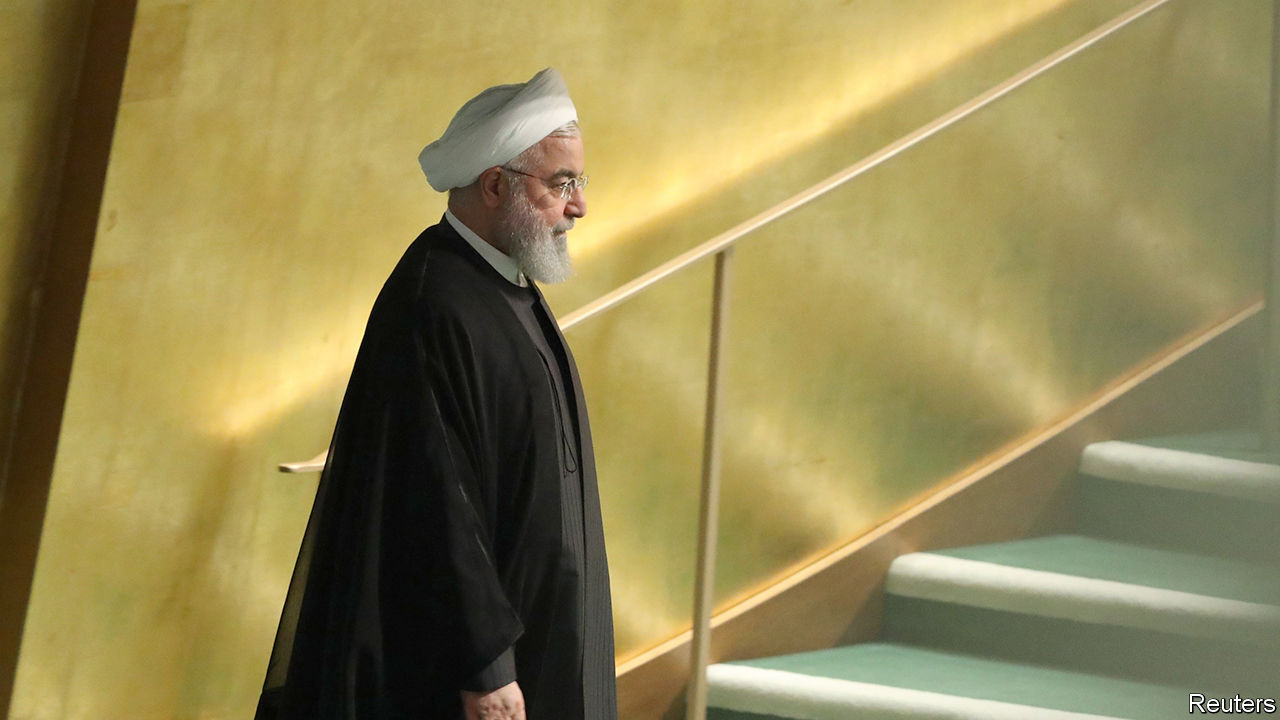
IT IS clear whom President Donald Trump blames for the Middle East’s problems. Iran’s “corrupt dictatorship”, he told the UN General Assembly on September 25th, “sows chaos, death and disruption” in the region. It used the economic benefits of its deal with America and other world powers, which curbed Iran’s nuclear programme in return for sanctions relief, to raise military spending and support terrorism, he claimed. So his administration pulled America out of the deal in May and launched “a campaign of economic pressure to deny the regime the funds it needs to advance its bloody agenda.”
Iran has responded, as usual, with defiance. Hassan Rouhani, its president (pictured), insisted he would not meet Mr Trump, denounced his “xenophobic tendencies resembling a Nazi disposition” and predicted victory over America. “The end of this war will be sweeter than the end of the eight-year war,” said Mr Rouhani, referring to Iran’s war with Iraq in the 1980s which left 600,000 Iranians dead. Though considered a pragmatist, he sounds much like Iran’s hardliners, who opposed his nuclear deal and see no room for compromise with America.
Mr Trump, though, is not the only one challenging the regime. Several gunmen killed at least 25 people, including 12 members of the Islamic Revolutionary Guard Corps (IRGC), the regime’s praetorian guard, at a military parade in Ahvaz, a city in the south-western province of Khuzestan, on September 22nd. Two different groups claimed responsibility. The first was a splinter of a local Arab separatist group, the Arab Struggle Movement for the Liberation of Ahvaz. But the Islamic State group, which a year ago stormed Iran’s parliament in Tehran, then promptly claimed the attack too, perhaps lying to boost its stature. The regime quickly, and with no hard evidence, blamed America and its regional “puppets”—Saudi Arabia, the United Arab Emirates (UAE) and Israel.
Iranian officials are fond of lurid conspiracy theories, but it is not hard to see why they suspect outsiders. Khuzestan is home to some 2m Arabs (most Iranians are Persian). In recent years Arab broadcasters have ramped up coverage of Iranian minorities, keenly supporting Arabs “under occupation by Persian forces”. Bahrain has gone as far as to name one of its streets “Arabian Ahvaz Avenue”. One of the groups that claimed responsibility for the attack did so through Iran International, a television station based in Britain and funded by Saudi investors. Last year Muhammad bin Salman, Saudi Arabia’s crown prince and de facto ruler, promised to take his country’s fight “inside Iran”.
In Iran’s eyes this Arab offensive is part of a broader, ominous front. Saudi Arabia and the UAE have set aside their differences with Israel in order to counter Iran, a shared enemy. Meanwhile, the White House is now full of officials who have spent much of their careers calling for regime change in Iran. Some senior members of Mr Trump’s team have supported the Mujahideen-e-Khalq, a cult-like dissident group that was until recently considered a terrorist organisation in Europe and America, and even provokes revulsion among reform-minded Iranians. Rudy Giuliani, Donald Trump’s lawyer, has taken the group’s cash; John Bolton, Mr Trump’s national security adviser, has hailed it as Iran’s “viable opposition”. On September 23rd an illustrious group of former American officials warned that Iran was being unwisely forced to choose between “capitulation or war”.
Iran’s sense of siege is likely to grow. On November 4th America will impose new sanctions aimed at Iran’s oil industry. As a result, Japan, South Korea, Sri Lanka and European countries plan to slash oil imports from Iran. America might offer cheap oil from its own reserves to induce India to follow. Though European states continue to uphold the nuclear deal, some have left Iran to twist in the wind. A French state-owned bank has dropped plans to finance exports to Iran, while the French government has restricted diplomatic travel to Iran and suspended the appointment of a new ambassador. Iran is seeking help from Russia and China. But Russia has gleefully filled the gap left by Iran in the oil market, while China is focused on its trade war with America.
The government’s focus on foreign plots deflects attention from problems at home. Khuzestan holds the vast majority of the country’s oil reserves but is poor and neglected. Arabs say they are kept out of local government and that the IRGC steals the region’s water as well as its oil. A plethora of dams have diverted rivers that flowed to the Gulf from central Iran, turning Khuzestan into a dust bowl. Protests have been brutally suppressed. Groups vowing to “liberate” Ahvaz claim to sabotage pipelines and shoot at officials.
The malaise is countrywide. Iran’s currency, the rial, has slumped in the past year. The poor, long the regime’s base of support, have to hoard food cans. Officials grow ever more corrupt to make up for the shrinking value of their salaries. Foreign businessmen, who flocked to Iran after the nuclear deal, have left. This year’s intake at the French school in Tehran was down from 350 to 150. Many Iranians want out, too. Such is the demand for work visas at the German consulate that applicants have to wait two years for an interview.
Years of sanctions have made Iran develop a “resistance economy”, which is diverse and in many areas self-sufficient. Prices of basics have risen, but by far less than they might have if Iran depended on imports. Cynics note that although the falling rial makes people poorer, it makes the government stronger, since Iran earns its oil revenue in foreign currency. Its reserves can survive two more years of Mr Trump, says Mr Rouhani. But suffering Iranians may prove a bigger threat to the regime.
No comments:
Post a Comment
Note: Only a member of this blog may post a comment.